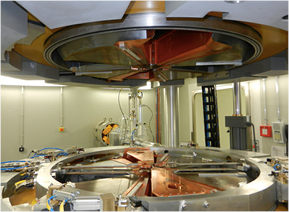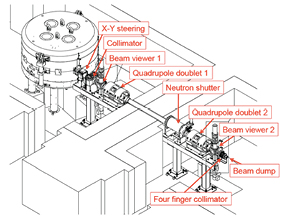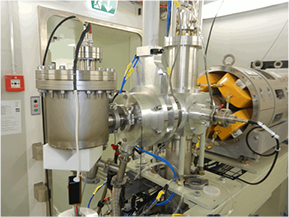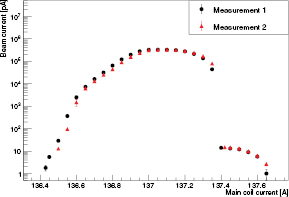Abstract
A medical cyclotron accelerating H− ions to 18 MeV is in operation at the Bern University Hospital (Inselspital). It is the commercial IBA 18/18 cyclotron equipped with a specifically conceived 6 m long external beam line ending in a separate bunker. This feature is unique for a hospital-based facility and makes it possible to conduct routine radioisotope production for PET diagnostics in parallel with multidisciplinary research activities, among which are novel particle detectors, radiation biophysics, radioprotection, radiochemistry and radiopharmacy developments. Several of these activities, such as radiobiology experiments for example, require low current beams down to the pA range, while medical cyclotrons are designed for high current operation above 10 μA. In this paper, we present the first results on the low current performance of a PET medical cyclotron obtained by ion source, radio-frequency and main coil tuning. With this method, stable beam currents down to ( ) pA were obtained and measured with a high-sensitivity Faraday cup located at the end of the beam transport line.
) pA were obtained and measured with a high-sensitivity Faraday cup located at the end of the beam transport line.
Export citation and abstract BibTeX RIS
1. Introduction
The establishment of a cyclotron laboratory at the Bern University Hospital (Inselspital) was made possible by a partnership between the Inselspital, the University of Bern (Physics and Radiochemistry) and private investors. This new centre [1] has a twofold purpose. It was principally conceived for top-level radioisotope production for positron emission tomography (PET) by means of the most advanced industrial good manufacturing practice (GMP) technologies. In addition, it was decided to exploit the high potential of this kind of facility for research activities in different fields [2]. Only rarely is a research and development programme pursued with a PET medical cyclotron, apart from clinical studies performed with the produced radiotracers. Nevertheless, valuable developments on accelerator physics, novel particle detectors, radiation protection, radiation biophysics and materials science can be performed, provided that regular access to the beam area is possible without limiting the routine use of the accelerator. Considering the severe restrictions due to radiation protection in radioisotope production machines, an external beam transport line (BTL) terminating in a separate bunker was included in the design of the facility [3]. Although more complex and unusual for a hospital-based accelerator, this solution allows the continuation of radioisotope production and multidisciplinary research activities in an independent and efficient way. Furthermore, several of the above mentioned research activities need low beam currents down to the pA range, while PET cyclotrons are designed and optimised for operation above 10 μA. To the authors' knowledge only the cyclotron of the University of Coimbra is operating a PET cyclotron for radiobiological applications [4]. There, low currents were obtained by long drift distances and without the use of a beam transport line.
The Bern cyclotron laboratory started operation at the end of 2012 and since then studies on particle detectors and air contamination have successfully been performed [5–8], and many other scientific activities are underway. A study on the possibility of reducing the beam currents down to the nanoampere and even picoampere range was performed and is presented in this paper. It has to be remarked that the stable operation of the IBA 18/18 cyclotron is only guaranteed above 10 μA. Furthermore, specific low irradiation conditions have to be reached without interfering with the daily radioisotope production for PET imaging. In this framework, low current performances were studied by acting in combination only on the ion source arc current, on the radio-frequency peak voltage and on the current in the main coil. On this basis, the beams can be further reduced in intensity and shaped by using collimators and compensators according to the specific need.
2. The Bern cyclotron and its beam transport line
The core of the facility is the IBA Cyclone 18 MeV cyclotron shown in figure 1. It is equipped with two H− ion sources, a redundancy aimed at maximising the efficiency for daily medical radioisotope production. It provides large beam currents up to 150 μA in single or dual beam mode. Extraction is achieved by stripping the negative ions with 5 μm thick pyrolytic carbon foils. In dual beam mode, the beam is extracted by two strippers located at an angular distance of about 180° from each other. The position of the last orbit can be tuned such that different currents can be extracted in the two out-ports. Although difficult to obtain, this feature was required for the Bern cyclotron in order to run two targets at the same time and produce two different radioisotopes. The main technical data of the Bern cyclotron are summarised in table 1.
Table 1. Main characteristics of the Bern cyclotron and its beam transport line.
| Constructor | Ion beam applications (IBA), Belgium |
| Type | Cyclone 18/18 HC |
| Accelerated particles | H− (D− on option) |
| Energy | 18 MeV (9 MeV for D−) |
| Maximum current | 150 μA (40 μA for D−) |
| Number of sectors | 4 |
| Angle of the dees | 30° |
| Magnetic field | 1.9 T on the hills and 0.35 T on the valleys |
| Radio frequency | 42 MHz |
| Weight | 24 000 kg |
| Dimensions | 2 m diameter, 2.2 m height |
| Ion sources | 2 internal PIG H− |
| Extraction ports | 8 (one of which connected with the BTL) |
| Extraction | Carbon foil stripping (for single or dual beam) |
| Strippers | Two per extraction port on a rotating carrousel |
| Isotope production targets | 4 18F− (15O, 11C and solid target are foreseen) |
| BTL | 6.5 m long; |
| two quadrupole doublets (one in each bunker); | |
| XY steering magnet; upstream collimator; | |
| 2 beam viewers; neutron shutter |
Figure 1. The Bern cyclotron opened during commissioning. The part of the BTL located in the cyclotron bunker is visible, pointing towards the wall separating the two bunkers.
Download figure:
Standard image High-resolution imageWhen operating at high beam currents, optimised vertical focusing and longitudinal phase stability are essential. This is realised by alternating along the accelerator circumference four 60° sectors at high magnetic field (hills) with four 30° sectors at low magnetic field (valleys). This implies that the particle orbits are not circular and that, during the construction, a complex and iterative mapping procedure is required to obtain a precise magnetic field. It has to be noted that a fine tuning of the cyclotron can be performed only on site by measuring the accelerated beam. In particular, the magnetic field of the Bern cyclotron was carefully set in the central region to obtain the optimal transmission of the low energy ions produced by the source. An iterative procedure was applied aimed at modifying the gap of the magnet in the central region (shimming).
The radioisotope production performance of the Bern cyclotron is excellent when compared with modern standards [9, 10]. In particular, 500 GBq of 18F can be produced with dual beam irradiation in less than 70 min. Considering the total efficiency of the chemical synthesis (usually about 60%), this corresponds to a production of about 250 GBq of fluorodeoxyglucose (FDG) in a single run. With this apparatus, even larger productions would be possible, but 500 GBq is the legal radiation protection limit for a laboratory of this type (classified as B) in Switzerland.
As already mentioned, a 6 m long BTL ending in a separate bunker is installed in Bern, which is quite uncommon for a PET medical cyclotron. These accelerators are usually equipped only with targets located right after the strippers and very rarely with one ∼2 m long beam line, dedicated to the bombardment of solid targets and located in the same bunker as the cyclotron. The BTL is able to transport the maximum current of 150 μA with more than 95% transmission efficiency and was designed, realised and commissioned with contributions from our group. High transmission is crucial to limiting unwanted activation and to protecting scientific equipment sensitive to radiation. Furthermore, this performance is important in view of future developments since remarkable progress is presently ongoing on targets that can withstand very large currents. At the same time, currents down to fractions of nA are needed for research purposes, and beams of different sizes ranging from a few millimetres to a few centimetres in diameter on target have to be obtained. Examples are radiation biology (flat beams of ∼1 cm2, ∼1 pA), PIXE and PIGE ion beam analysis (beams of ∼1 mm2, ∼1 pA), cross section measurements (beams of ∼10 mm2, ∼10 nA). To fulfill these goals, specific solutions were implemented and the initial industrial design was modified accordingly [4].
A schematic view of the BTL is shown in figure 2. The alternate focusing and defocusing of the BTL is realised by two horizontal–vertical (H–V) quadrupole doublets, the former located in the cyclotron bunker and the latter in that of the BTL. An unavoidable design constraint is represented by the distance between the two quadrupole doublets due to the 180 cm thick wall separating the two bunkers. This thickness is due to radiation protection issues since considerably fast neutron fluxes are generated during radioisotope production, for example, via (p,n) reactions. For the same reason, a movable cylindrical neutron shutter is located inside the beam pipe when the BTL is not in use. In this way, the penetration of neutrons to the second bunker through the beam pipe is minimised. Taking into account the space needed for the vacuum pumps, beam diagnostics, collimators and other devices, the beam line is 6.5 m long. For scientific activities, experimental equipment such as particle detectors or specific target stations are installed at the end of the BTL.
Figure 2. Schematic view of the Bern cyclotron facility, where all the main elements of the BTL are highlighted.
Download figure:
Standard image High-resolution image3. Experimental set-up
The study presented in this paper is based on the tuning of the ion source, the radio-frequency (RF) and the current in the main coil as well as on the precise measurement of the beam current at the end of the BTL. Since currents in the nA and pA range are uncommon for PET cyclotrons, commercial instrumentation is not standard. For this reason, a specific apparatus was developed by our group.
For the measurement of the beam current in the BTL, the two viewers and the beam dump shown in figure 2 are equipped with a read-out device integrated in the control system of the cyclotron. When one of the viewers is lowered to intercept the beam, it acts as a Faraday cup and the beam current can be measured by an ammeter. With this method, a sensitivity, namely the minimal measurable current, of the order of 10 nA can be reached. This system is therefore not suitable for the investigation of the intensity range (from a few pA to a few nA) we are aiming at in this work. For this purpose, a high-sensitivity Faraday cup [11] was used, as shown in figure 3. To reduce the effects due to secondary electrons to a negligible level, a polarisation potential of 1000 V was applied to a guard ring preceding the cup. The dependency of the measured current on the polarisation potential shows that most of the secondary electrons are stopped at 50 V. Any voltage above this value guarantees operation in the plateau region. To avoid ground loops, the cup on which the protons impinged was not connected with the ground potential of the accelerator and was left floating. The diameter of the cup is 40 mm. The produced signals were sent to a digital electrometer (Keithley model 616) with a sensitivity of about 1 pA. The values of the current obtained using both the second viewer and the Faraday cup were compared for currents above 10 nA. A good agreement between the two measurements was found, as reported in figure 4. The current measured with the read-out device at the second BTL viewer was found to be a linear function of the current measured with the Faraday cup. The function was fitted to the data with the slope  . The settings of the quadrupoles were optimised to eliminate beam losses between the second viewer and the cup.
. The settings of the quadrupoles were optimised to eliminate beam losses between the second viewer and the cup.
Figure 3. The high sensitivity Faraday cup installed at the end of the BTL for low current performance studies.
Download figure:
Standard image High-resolution imageFigure 4. Beam current measured with the integrated read-out device at the second BTL viewer as a function of the current measured by the Faraday cup. The line represents the result of a linear fit.
Download figure:
Standard image High-resolution image4. Experimental results
In order to obtain currents as low as a few μA, the arc current of the ion source can be reduced without changing any other parameter with respect to the set-up used for routine radioisotope production with intensities of about 70 μA in single beam mode. In general, the arc current needed to have a given current on target depends on the performance of the ion source. For radioisotope production, the ion source is set to 300–600 mA for currents on target in the range 70–150 μA. To obtain stable beam conditions at low currents, the plasma inside the source has to be stable. For this reason, the minimum possible arc current is set to 1 mA, producing about 0.5 μA on target. This minimum setting of the arc current of the ion source was kept constant for all the measurements described in this paper. For the quadrupole doublets and the XY steering magnet of the BTL, the standard configuration optimised for the irradiation of solid targets was used. It guarantees a transmission efficiency higher than 95% from the stripper to the Faraday cup [4].
The accelerating peak voltage provided by the 42 MHz RF system can range from 26.5 to 36 kV. A decrease in the current on target is expected when the RF peak voltage is decreased [12]. This effect is mostly due to the fact that the puller is able to extract more H− ions from the chimney of the ion source for larger values of the electric field acting on the periphery of the plasma. To study this effect in detail, the beam current was measured as a function of the RF peak voltage. The results are reported in figure 5. A smooth decrease of more than a factor of four was observed when passing from 36 kV to 26.5 kV. For these measurements, the current of the main coil was set to 137.05 A, which corresponded to the optimal isochronism and, consequently, to the maximum extracted current. The decrease in the intensity may also have been due to a change of the initial beam Twiss parameters from the ion source to the injection to the cyclotron. This would lead to transverse mismatching with consequent beam losses. To examine this effect, the RMS of the beam distribution in the horizontal plane was evaluated as a function of the RF peak voltage by means of a beam profile detector [5], as reported in figure 6. This detector was located at the end of the BTL, just in front of the Faraday cup. At values of the RF peak voltage below 30 kV, a decrease in the beam size was observed. A maximum decrease in the beam width was measured to be about 50% at the lowest voltage of 27 kV.
Figure 5. Beam current measured by the Faraday cup as a function of the RF peak voltage. The error bars are not visible due to the small uncertainties.
Download figure:
Standard image High-resolution imageFigure 6. The RMS of the horizontal beam distribution measured as a function of the RF peak voltage.
Download figure:
Standard image High-resolution imageTo further decrease the extracted current, it is possible to operate the cyclotron with a magnetic field which does not correspond to the optimal isochronism. Therefore, the beam current at the end of the BTL was studied as a function of the current in the main coil ( ). Several consecutive sets of measurements were performed and good agreement was found thus demonstrating the reproducibility of the obtained values. Two series of collected data are shown in figure 7, where the circles and triangles correspond to measurements performed by increasing and decreasing the current in the main coil, respectively. A smooth increase in the beam current was observed when going from low values of
). Several consecutive sets of measurements were performed and good agreement was found thus demonstrating the reproducibility of the obtained values. Two series of collected data are shown in figure 7, where the circles and triangles correspond to measurements performed by increasing and decreasing the current in the main coil, respectively. A smooth increase in the beam current was observed when going from low values of  towards the isochronism condition. In this region, stable currents of a few pA were obtained. The slope of the curve is such that small variations of
towards the isochronism condition. In this region, stable currents of a few pA were obtained. The slope of the curve is such that small variations of  do not have a large influence on the current on target. After the isochronism condition, the extracted current decreases and shows a kink at about
do not have a large influence on the current on target. After the isochronism condition, the extracted current decreases and shows a kink at about  A. Here the beam is unstable. This effect may be due to the interception of the beam by the body of the second ion source or to a resonant condition producing beam losses. Due to the presence of a discontinuity, the part of the curve above the optimal isochronism is therefore less suitable for stable low current operation.
A. Here the beam is unstable. This effect may be due to the interception of the beam by the body of the second ion source or to a resonant condition producing beam losses. Due to the presence of a discontinuity, the part of the curve above the optimal isochronism is therefore less suitable for stable low current operation.
Figure 7. Beam current measured by the Faraday cup as a function of the current in the mail coil of the cyclotron. The circles and the triangles correspond to two different sets of measurements.
Download figure:
Standard image High-resolution imageWith the goal of obtaining the lowest current, the value of ( ) pA was reached. The uncertainty includes the precision of the electrometer and effects due to beam instabilities. This is at the limit of the sensitivity of the electrometer used for our measurements. The mean current read by the device while the system is operational but the beam is interrupted before the Faraday cup is of (
) pA was reached. The uncertainty includes the precision of the electrometer and effects due to beam instabilities. This is at the limit of the sensitivity of the electrometer used for our measurements. The mean current read by the device while the system is operational but the beam is interrupted before the Faraday cup is of ( ) pA. This negative current value can be explained by the slight induction caused by the stoppage of the beam just in front of the Faraday cup. This clearly shows that our lowest measured current is not part of the system's baseline noise. The stability of the beam current was observed for a period of about ten minutes within the uncertainty.
) pA. This negative current value can be explained by the slight induction caused by the stoppage of the beam just in front of the Faraday cup. This clearly shows that our lowest measured current is not part of the system's baseline noise. The stability of the beam current was observed for a period of about ten minutes within the uncertainty.
5. Conclusions
The study presented in this paper demonstrates for the first time the possibility of using a medical cyclotron to produce stable currents from a few pA to a few nA only by acting on the ion source, radio-frequency and main coil tuning. With this method, stable beam currents down to ( ) pA were obtained. This represents a reduction of seven orders of magnitude with respect to the design range of beam currents needed for radioisotope production. The obtained results open the way for several multidisciplinary scientific activities usually not performed with this kind of accelerators such as, for example, radiation biophysics.
) pA were obtained. This represents a reduction of seven orders of magnitude with respect to the design range of beam currents needed for radioisotope production. The obtained results open the way for several multidisciplinary scientific activities usually not performed with this kind of accelerators such as, for example, radiation biophysics.









